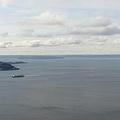 結合政府、原住民部落、科學家與企業力量,共同保育華盛頓州普吉灣的「普吉灣協作會」(Puget Sound Partnership)表示,每年有大量有毒化學物質隨著遭受污染的逕流廢水進入普吉灣,總量高達5200萬磅,平均一天就有15萬磅(68公噸),相當於每兩年就發生一次愛克森瓦拉茲(Exxon Valdez)油輪的嚴重漏油事故。
結合政府、原住民部落、科學家與企業力量,共同保育華盛頓州普吉灣的「普吉灣協作會」(Puget Sound Partnership)表示,每年有大量有毒化學物質隨著遭受污染的逕流廢水進入普吉灣,總量高達5200萬磅,平均一天就有15萬磅(68公噸),相當於每兩年就發生一次愛克森瓦拉茲(Exxon Valdez)油輪的嚴重漏油事故。
這些有毒化學物質包括石油與石化產品、鉛、 鄰苯二甲酸鹽(phthalates),以及100萬磅的鋅與銅等有毒金屬。其中金屬的排放濃度雖然比石油與石化產品低,卻會對鮭魚造成傷害威脅。
協作會的執行長迪克斯(David Dicks)指出,「這些數字令人吃驚,也威脅普吉灣40種以上的生物,包括海灣中的虎鯨族群,我們注意到過去幾個月數量減少了近一成。」
為了保育並清理普吉灣,協作會在11月6日公佈一份行動方針草案,內容涵蓋了西雅圖與塔科瑪(Tacoma)一帶的都會區,居住人口約5百萬。草案中建議「以廣泛、整合性的方式,管理都市與郊區地表的逕流排放」。
草案內容還將協調當地社區,建立有效的駐地廢水管理系統並加以維護,針對容易遭受污染的地表逕流,減少毒物含量。
這項行動方針將從來源著手,防止污染物進入普吉灣的生態系。為了處理海灣內現存的污染物,清除水中與陸地有毒物質的工作也被列為首要之務。
如果行動草案獲得採納,溪流將可得到保育以提供自然界及人類使用。為了避免開發重要與敏感的生態區域,草案也提倡將都市與重點聚落集中發展。
根據草案,協作會也將執行並維護重要的生態復育計畫,包括海洋、臨岸、河口、淡水流域與陸地。這項行動計畫還能幫助近海社區復甦,改善海洋與溪流沿岸的環境,並提升私人地主實行復育計畫的能力。
迪克斯表示,有兩份最新的分析報告支持行動方針的觀點,對普吉灣生態健康方面的狀態與趨勢提出警告。報告證實化學物質主要經由地表逕流進入海灣,與州政府之前的發現相符。隨著人口與土地開發增加,流入普吉灣的污染物主要是由人類日常活動產生。
迪克斯說,「行動方針是讓普吉灣復原的絕佳機會,確保我們能留下一個乾淨、健康的海灣,讓後代子孫津津樂道。要仰賴所有人一起攜手參與解決問題,我們才能得到成功。」
下載污染報告與摘要。
Each year, 52 million pounds of toxic chemicals - nearly 150,000 pounds per day - inundate Puget Sound with contaminated runoff. This amounts to a toxic spill the size of Exxon Valdez every two years, according to the Puget Sound Partnership, a community effort of governments, tribes, scientists and businesses working together to restore and protect the Sound.
The toxic chemicals include oil and petroleum products, lead, and phthalates - and one million pounds of toxic metals such as zinc and copper. These metals, despite being released in lower concentrations than oil and petroleum, can harm threatened salmon species.
"These disturbing numbers are putting more than 40 species in Puget Sound at risk, including the Sound's orca population, where we just saw a decline of nearly 10 percent in the past several months," said the Partnership's Executive Director David Dicks.
The Puget Sound Partnership Thursday released a draft Action Agenda for protecting, restoring and cleaning up Puget Sound, which encompasses the Seattle-Tacoma metropolitan area, home to about five million people.
The draft Action Agenda recommends using "a comprehensive and integrated approach to managing urban stormwater and rural surface water runoff."
Among other measures, it would establish and maintain locally coordinated, effective on-site sewage system management to reduce pollutant loading to vulnerable surface waters.
It would prevent pollutants from being introduced into Puget Sound ecosystems in the first place, and to deal with contaminants already in the Sound it would prioritize and implement projects to clean up toxic contamination in water and upland areas.
If the draft agenda is adopted, it would protect and conserve stream flows for natural system and human uses and focus growth away from ecologically important and sensitive areas by encouraging dense, compact cities and vital rural communities.
Under the plan, the Partnership would implement and maintain priority ecosystem restoration projects for marine, nearshore, estuary, freshwater riparian and uplands.
It would revitalize waterfront communities while enhancing marine and freshwater shoreline environments and increase private landowners' ability to undertake restoration projects.
New analysis supporting the draft Action Agenda identifies some "alarming" facts and trends related to the health of Puget Sound, said Dicks.
Two pollution reports confirm the state's previous findings that surface runoff is the main pathway of the toxic chemicals getting into the Sound.
The primary sources of toxics to Puget Sound are the day-to-day activities of people, as the population grows and land gets more and more developed.
"The Action Agenda is the best chance we have to repair the damage to Puget Sound and ensure we leave a legacy of a clean and healthy Puget Sound for our children and grandchildren," Dicks said. "Success truly depends on all of us coming together and being a part of the solution."
The reports, and a summary document, can be found online at http://www.ecy.wa.gov/programs/wq/pstoxics/index.html


